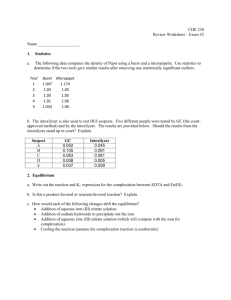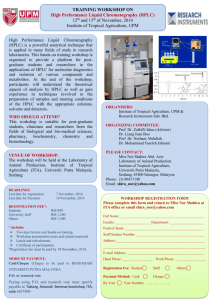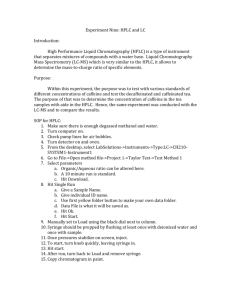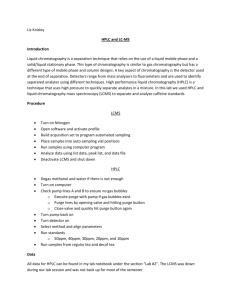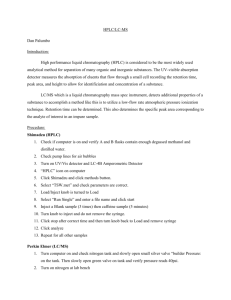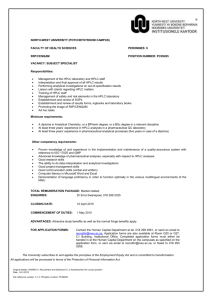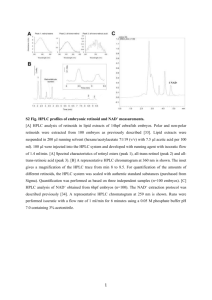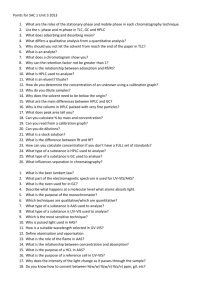Final Exam Review
advertisement
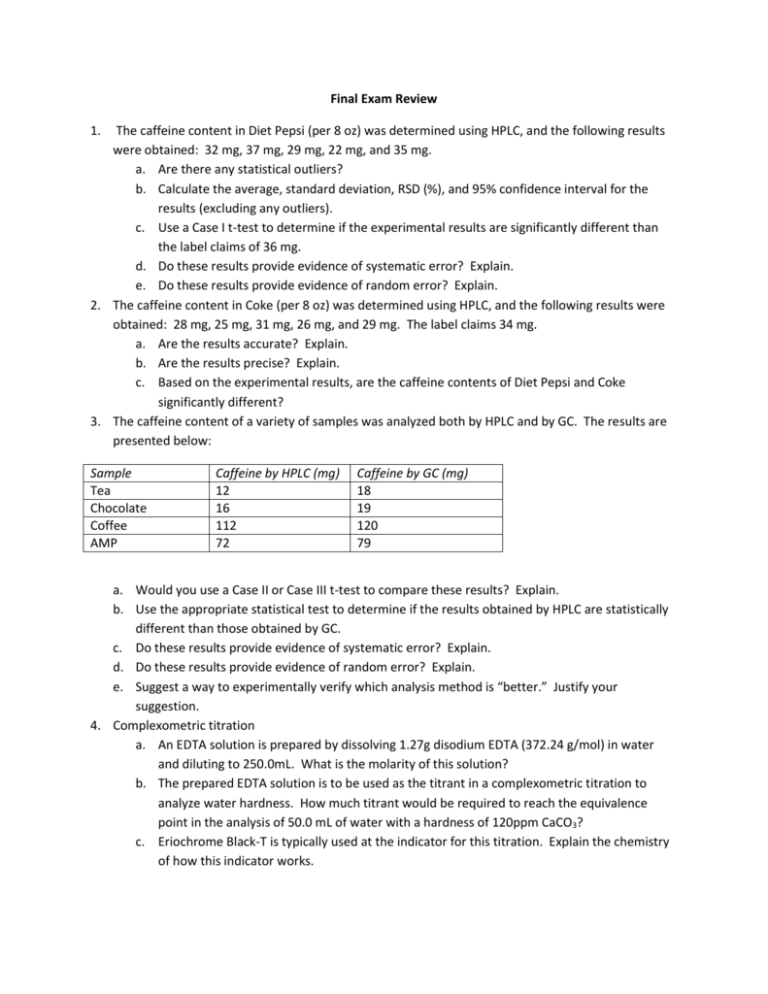
Final Exam Review 1. The caffeine content in Diet Pepsi (per 8 oz) was determined using HPLC, and the following results were obtained: 32 mg, 37 mg, 29 mg, 22 mg, and 35 mg. a. Are there any statistical outliers? b. Calculate the average, standard deviation, RSD (%), and 95% confidence interval for the results (excluding any outliers). c. Use a Case I t-test to determine if the experimental results are significantly different than the label claims of 36 mg. d. Do these results provide evidence of systematic error? Explain. e. Do these results provide evidence of random error? Explain. 2. The caffeine content in Coke (per 8 oz) was determined using HPLC, and the following results were obtained: 28 mg, 25 mg, 31 mg, 26 mg, and 29 mg. The label claims 34 mg. a. Are the results accurate? Explain. b. Are the results precise? Explain. c. Based on the experimental results, are the caffeine contents of Diet Pepsi and Coke significantly different? 3. The caffeine content of a variety of samples was analyzed both by HPLC and by GC. The results are presented below: Sample Tea Chocolate Coffee AMP Caffeine by HPLC (mg) 12 16 112 72 Caffeine by GC (mg) 18 19 120 79 a. Would you use a Case II or Case III t-test to compare these results? Explain. b. Use the appropriate statistical test to determine if the results obtained by HPLC are statistically different than those obtained by GC. c. Do these results provide evidence of systematic error? Explain. d. Do these results provide evidence of random error? Explain. e. Suggest a way to experimentally verify which analysis method is “better.” Justify your suggestion. 4. Complexometric titration a. An EDTA solution is prepared by dissolving 1.27g disodium EDTA (372.24 g/mol) in water and diluting to 250.0mL. What is the molarity of this solution? b. The prepared EDTA solution is to be used as the titrant in a complexometric titration to analyze water hardness. How much titrant would be required to reach the equivalence point in the analysis of 50.0 mL of water with a hardness of 120ppm CaCO3? c. Eriochrome Black-T is typically used at the indicator for this titration. Explain the chemistry of how this indicator works. 5. Calculate the pH for each of the following: a. 0.082M sodium hydroxide b. 0.105M formic acid c. A mixture of 20.0mL of 0.075M ammonia and 15.0mL of 0.095M ammonium nitrate. 6. 25.0mL of 0.10M hydrochloric acid is being titrated with 0.15M potassium hydroxide. Calculate the pH at each of the following volume additions: f. 7.5mL of titrant added g. 16.7mL of titrant added h. 21.3mL of titrant added 7. Solubility and Ksp a. Write out the balanced chemical equation that represents the solubility product constant for copper (II) hydroxide. b. Considering a 100mL saturated solution of copper (II) hydroxide, indicate whether each of the following adjustments would cause more to dissolve, more to precipitate, or no effect. i. Adding copper (II) nitrate to the solution. ii. Adding 50mL of water iii. Heating the mixture iv. Raising the pH v. Adding sodium nitrate to the solution c. Calculate the solubility of copper (II) hydroxide in g per 100mL. d. You are going to perform a gravimetric analysis of copper (II) ions by adding excess hydroxide. If you have 50.0mL of a 0.12M copper (II), what mass of precipitate would form? 8. UV-VIS Spectroscopy a. The UV-VIS spectrum for a solution of a particular type of nanoparticle, PANI, is shown in the dark trace. What is the 𝜆max for this nanoparticle solution? b. If this spectrum is for a concentration that is 2.5*10-5M, what is the approximate extinction coefficient at this wavelength? c. Which wavelength would you use for analysis if you were using a glass cuvette? Explain. d. What color would you expect this solution to be? Explain. 9. Fluorescence a. The structure of the amino acid tryptophan is shown. What about its structure makes it fluorescent? b. Tryptophan’s optimal wavelength of excitation is 270nm, and the optimal wavelength of emission is 350nm. Explain why emission occurs at a longer wavelength than excitation. c. Calculate the energy and frequency of fluorescence light from tryptophan. 10. Chromatography a. A separation of a three component mixture is shown. Do you think this is an example of reverse phase liquid chromatography, normal phase liquid chromatography, or gas chromatography? Explain. b. Which compound in this mixture has the highest concentration? Explain. c. Does this separation demonstrate good efficiency? (No calculations required.) Explain. d. Does this separation demonstrate good resolution? (No calculations required.) Explain. 11. The active ingredient in Tylenol, acetaminophen, was analyzed using HPLC. Two standards and one sample were analyzed, and the results Standard Retention time (min) Peak Area 50 ppm acetaminophen 1.389 min 104,500 are shown. A Tylenol pill weighing 150 ppm acetaminophen 1.411 ming 320,100 305mg was crushed up. 112mg of the prepared acetaminophen 1.392 ming 180,200 crushed pill was then added to a 1000mL volumetric flask and diluted to volume. A 20µL sample was injected into the HPLC for analysis. a. Calculate the mass (mg) of active ingredient in the Tylenol pill. b. Calculate the percentage of active ingredient in the pill.


